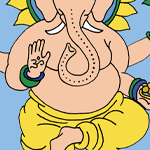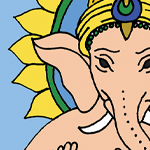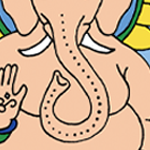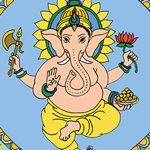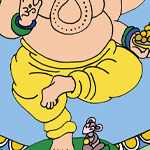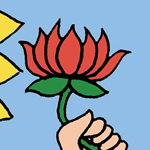Watch nearly 400 videos on the Vocal Medicine Channel!
Ganesha Symbol Meaning
Ganesha symbol meaning reveals the amazing qualities of one of the most well-known and popular deities in the Hindu pantheon. He is also known as Ganapati or Lord Ganesh. He is the colorful and memorable elephant-headed son of Shiva and Parvati.
Role of Ganesha
This beloved deity is commonly believed to be the ruler of new beginnings, success, wisdom, letters, and learning. He is also recognized as the remover of obstacles for his devotees.
Share this page with a friend!
Ganesha Symbol Iconography
Ganesha is a joyful being associated with extensive symbolism. Ganesha’s symbols help the viewer to understand the significance of this unusual deity. Explanations for Ganesha’s more common symbols are given below. These symbols are based on artwork and statues depicting Ganesha.
Ganesha Symbol: His Large Belly
Ganesha’s large stomach indicates that he contains all of the universes (cosmic eggs) of the past, present, and future. Ganesha’s belly also represents the ability to digest all experiences in life. Finally, the large belly of Ganesh symbolizes prosperity and abundance. This includes an abundance of food and all material possessions.
Ganesha Symbol: His Elephant Head
Elephants use their heads to break paths through the forest. This symbolizes breaking through obstacles on every level. In addition, elephants have small eyes in proportion to their large heads. This symbolizes the ability to focus and concentrate.
Ganesha Symbol: His Small Eyes
In addition, elephants are purported to see things bigger than they actually are. This is connected with the psychological symbolism of humility and the surrendering of pride. On the other hand, the mouth of an elephant is proportionately large. This represents the natural desire to enjoy food and life.
Ganesha Symbol: Large Ears
Ganesha’s large elephant ears represent willingness to listen and bring together ideas. This creates success in human affairs. Ganesha’s large ears also indicate the wisdom of hearing all sides of an issue. In the natural world, the large ears of the elephant help to keep them cool in a hot desert environment. The blood vessels of the ears are close to the skin and release heat.
Ganesha Symbol: His Trunk
Ganesha’s trunk is able to hold anything in the universe. This symbolizes the idea that successful people hold whatever life brings. The trunk of an elephant has the ability to uproot large trees or to pick up a small needle. This signifies mastery in both the physical world and in the world of more subtle energy and vibrations. Next to the trunk are two tusks.
Broken Tusk Symbol
Sometimes one of the tusks (the left one) is depicted as broken. Ganesha’s two tusks represent wisdom and emotion – the right being wisdom and the broken left representing emotion. His broken tusk tells people that they must overcome their emotions with wisdom to attain perfection.
Symbolism of Ganesha’s Arms
Ganesha’s four-armed form represents the inner attributes of the subtle body: mind, intellect, ego, and conscience. In addition, Ganesha’s four arms possess four different symbolic objects: an axe, a lotus, a plate of sweets and a symbol of OM in his palm.
Ganesha Symbol: Blessing Hand
One of Ganesha’s hands is typically turned towards the viewer in a gesture of blessing, refuge, and protection. This hand position is called the Abhaya mudra. A mudra is a symbolic gesture said to send energy out from the body for a specific purpose. The OM symbol inscribed on Ganesha’s palm represents the sound of all of creation.
Symbolism of Ganesha’s OM
The hand with the OM symbol is held in a traditional gesture of blessing. Ganesha can be pictured with anything from two to 16 arms. The four-armed version is the most common.
Ganesha Symbol: His Axe
Ganesha’s axe symbolizes cutting off desires. He can also destroy obstacles or move a person to the right path with his axe. The axe also symbolizes the power to cut the bonds of ignorance. Sometimes a pen is depicted in place of the axe. In this case, the pen represents knowledge that can remove ignorance as effectively as the power of an axe.
Symbolism of Ganesha’s Yellow Clothing
Ganesha wears yellow as a reminder to all to cultivate purity, peace, auspiciousness, self-control, and truthfulness. Yellow is Ganesha’s favorite color. Yellow is the color of tumeric, a spice that has symbolic meaning associated with the sun, abundance and wisdom. Tumeric is used in Hindu weddings and other significant rituals.
Ganesha Symbol: Lotus Flower
One of Ganesha’s hands holds a lotus flower. This symbolizes the realized inner self. The color red indicates activity in the world. The lotus flower is one of the most heavily used symbols in the East. Many deities are depicted sitting on a lotus flower. The lotus symbolizes attaining enlightenment as the ultimate fulfillment of life.
Why the Lotus is India’s National Flower
Lotus flowers mean purity, rebirth and divinity. As a consequence, the lotus is the national flower of India. Additionally, the blue lotus is the sacred water-lily of both Hinduism and Buddhism. In addition, lotus roots are used widely in Asian cooking. In terms of colors, lotus are usually white or pink. They can also be yellow, red, purple or blue. Learn more about Flower Color Meanings.
Ganesha Symbol: His Favorite Sweets
Sometimes Ganesha is pictured with common Indian sweets in his hand. He is known to have a fondness for sweets. However, Ganesha’s treats are not merely for the pleasure of taste. Instead, these treats symbolize the rewards for a life of service and the eternal sweetness that is available following many lifetimes of right living.
Ganesha Mouse Symbolism
The mouse or rat represents ego and the wandering of the human mind. Ganesha stands over the mouse or rat, meaning that he has complete control over ego and the mind. The mouse finds food in the darkness. This food is like negative mental traits that dominate during times or darkness or ignorance. Ganesha has used wisdom to conquer all negative mental traits.
Author Kathleen Karlsen
Kathleen Karlsen is a musician, artist, writer and speaker. She is the author of two books (Flower Symbols and Vocal Medicine) and over 200 articles. Kathleen, her husband Andrew, and their five children live in Bozeman, Montana. More about Kathleen Karlsen.
GANESHA SYMBOL ARTICLE SUMMARY
Ganesha is well-known in the East as an aspect of God to appeal to at the beginning of new endeavors. He is the Hindu god of overcoming, a fusion of an elephant head and a human body, something like Western superheroes. This article covers an array of Ganesha symbols.

